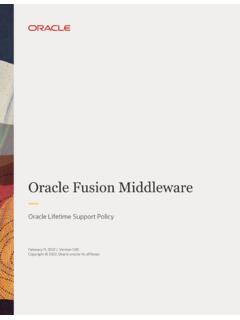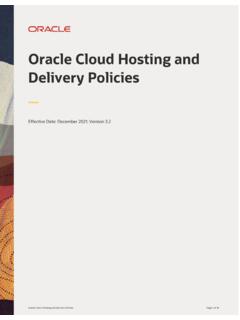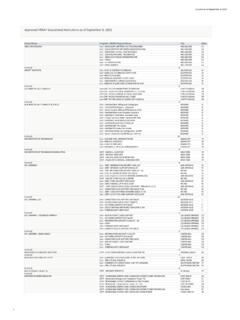Transcription of The Hidden Costs of Oracle Applications 2.4
1 Enterprise Applications 5 1 0 . 5 4 0 . 8 6 5 5 Joshua Greenbaum, Principal Enterprise Applications ConsultingFall, 2011 The Hidden Costs of Oracle Applications : The Return on Investment that Doesn t Add Up Executive Summary Enterprise Applications customers are facing unprecedented pressure to better manage Costs associated with their Applications , infrastructure software, and hardware, as the twin effects of recessionary economics and rapidly expanding global business opportunities take hold. It is essential that enterprises critically evaluate the long-term total cost of ownership (TCO) of their enterprise software portfolios to lower on-going Costs and better direct spending towards innovation. With this in mind, Enterprise Applications Consulting has taken a critical look at the TCO of Oracle Applications with an eye towards providing existing and prospective customers a sense of not just the absolute cost of Oracle s Applications , but also the relative cost vis- -vis the competition.
2 This analysis is based on looking at a 5-10 year time frame, from initial acquisition through at least two technical and/or functional upgrades. Within this framework, EAC has identified a number of key areas where Hidden Costs may unfavorably impact the TCO of Oracle Applications : Customers looking to use their enterprise software as a platform for business growth often have to choose between using an existing business process in an Oracle suite product that has been effectively sidelined by the acquisition of a best of breed product or go through a migration to a wholly new product. Customers must take responsibility for and bear the cost of wiring up their Oracle Applications and associated business processes. Oracle s M&A strategy means that innovation results primarily from acquisition, and, because of SEC regulations and market dynamics, Oracle is unable to provide an accurate innovation roadmap to customers.
3 Customers are locked in to the Oracle DBMS and middleware, and are subject to frequent price increases. Oracle prohibits customers from streamlining their database environments by imposing maintenance cost escalators on customers that try to decommission or collapse their database licenses. Oracle customers are frequently forced to turn an upgrade project into a reimplementation, at a cost many times greater than what an upgrade would cost . This is true for Oracle s legacy Applications as well Fusion Applications . Fusion Applications customers looking for industry-specific functionality must integrate their new Applications with the existing Oracle or non- Oracle Applications that support the required industry functionality. Oracle s plans for migrating its customers from older, non- Oracle hardware to the company s new Exadata and Exalogic systems do not provide net savings on license and maintenance for those customers.
4 While there are certainly customers who are able to obtain considerable value from their Oracle Applications environments, that value comes at a price that may be excessive, in particular when viewed through the lens of competing, integrated products that don t require the customer to pay for and manage the integration of key business processes across the enterprise software environment. Oracle s attempts to dial back to a monopolistic vision of enterprise Applications deployments need not be the only option. There are numerous ways in which Oracle customers can lower their TCO and support their innovation requirements without having to run the gauntlet of Oracle s Hidden Costs . This can be done through the adoption of non- Oracle Applications that have a more predictable roadmap that supports pre-integrated innovation, a much simpler and less onerous upgrade strategy, and that do not require a significant investment in one vendor s hardware and database vision and cost structure.
5 The options are there for Oracle customers, and the threat to the total cost of ownership of their enterprise Applications and business processes makes it imperative that they consider these alternatives. Table of Contents Introduction: Oracle s Applications Strategy and the Challenges of Business and IT 1 Applications Complexity, Integration Costs , and the Hidden Applications 2 Hidden DBMS, Middleware, and Other 4 Hidden Migration and Upgrade 5 Conclusion: Avoiding the Oracle Complexity 7 Oracle s Hidden Costs An EAC Report Copyright 2011 EAC 1 Introduction: Oracle s Applications Strategy and the Challenges of Business and IT Today Enterprise Applications customers are facing unprecedented pressure to better manage Costs associated with their Applications , infrastructure software, and hardware, as the twin effects of recessionary economics and rapidly expanding global business opportunities take hold.
6 These two forces are pushing IT organizations and line of business management to find ways in which they can simultaneously lower day to day IT Costs while increasing spending on innovative software and business processes as never before. Faced with a complex set of issues, it is essential that enterprises critically evaluate the long-term total cost of ownership (TCO) of their enterprise software portfolios to lower on-going Costs and better direct spending towards innovation. With this in mind, Enterprise Applications Consulting has taken a critical look at the TCO of Oracle Applications with an eye towards providing existing and prospective customers a sense of not just the absolute cost of Oracle s Applications , but also the relative cost vis- -vis the competition. The result of this effort showcases a number of key areas where Oracle technology, Applications , and business strategy result in excessive cost and complexity by driving up IT spending, promoting expensive upgrade options, and otherwise potentially saddling the customer with a host of Hidden Costs .
7 Not every customer will find his or her company confronting every potential Hidden cost . For many Oracle customers, however, following Oracle s product strategy can lead to at best an overly complex TCO model rigged very much in Oracle s favor, and at worst, a budget-draining TCO model that is completely at odds with the business and technical requirements of today s enterprise. Importantly, customers and prospects trying to understand the Hidden Costs of Oracle s application strategy need to look at the long-term Costs of buying into not just the specific Applications that Oracle is offering, but also at the underlying middleware and hardware technologies, as well as other key strategic issues that can have a significant impact on long-term TCO. As Oracle is increasingly locking its customers into its particular software and hardware vision, the long-term impact of such a lock-in must be taken into consideration in any comprehensive analysis of the TCO of Oracle Applications .
8 As such, this analysis is based on looking at a 5-10 year time frame, from initial acquisition through at least two technical and/or functional upgrades. Within this framework, EAC has identified three key areas where Hidden Costs may unfavorably impact the TCO of Oracle Applications : The built-in complexity of the Oracle Applications portfolio and roadmap, and the do-it-yourself integration burden. Hidden Costs of database and middleware. Oracle s Hidden Costs An EAC Report Copyright 2011 EAC 2 Hidden complexity and Costs of migration and upgrade. Taken together, these three issues should be weighed carefully by any company looking at either acquiring Oracle Applications or considering an upgrade to an existing Oracle Applications instance. Applications Complexity, Integration Costs , and the Hidden Applications Roadmap The complexity of the Oracle Applications stack can be a major impediment to controlling Costs , due primarily to the existence of multiple different code bases and data models across the company s product portfolio.
9 This complexity is compounded by the extraordinary overlap between the major products in terms of data models and business processes. Common data objects such as customer are found in multiple versions across the Oracle portfolio both in core products such as eBusiness Suite (EBS), PeopleSoft, Siebel, Oracle CRM, and Fusion CRM as well as in industry-specific products like Agile and Retek. The same is true with key business processes. Core financial processes are offered as part of EBS, JDE, PeopleSoft, and Fusion, as well as Siebel and Retek, with specific financial planning software provided by best of breed application Hyperion. Similarly, project management exists as a process supported by several products in the Oracle portfolio, including EBS, JDE, and PeopleSoft, as well as in best of breed portfolio Applications such as Primavera. While presented as part of a strategy to bring best of breed Applications to market, Oracle s product overlap complicates implementation, life-cycle maintenance , and overall business process excellence.
10 Customers looking to use their enterprise software as a platform for business growth often have to choose between using an existing business process in an Oracle suite product such as project management that has been effectively sidelined by the acquisition of a best of breed product like Primavera or go through a migration to a wholly new product. While these orphaned business processes are maintained and supported by Oracle as legacy solutions, customers looking to upgrade the project management function in, say, EBS, are forced to license a net-new product from Oracle , as opposed to getting a free upgrade through their maintenance contract. Exacerbating this overlap and lifecycle management problem is the problem of the lack of transparency with regards to Oracle s product roadmap and its impact on their customers ability to plan for innovation. Oracle s seven year, multi-billion dollar M&A strategy has made it clear that innovation results primarily from acquisition, and, due to the dual requirements of SEC regulations and market dynamics, Oracle is simply unable to provide an innovation roadmap that would include likely future functionality or industry support.


